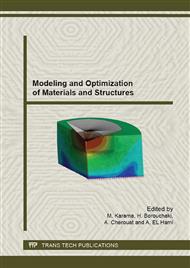p.1
p.9
p.17
p.25
p.32
p.37
p.41
p.44
3D Remeshing Simulation of Aluminum Foams Behavior under Static Load
Abstract:
The compression characteristics of open-cell aluminum foams were experimentally and numerically investigated. It is found that the mechanical parameters, such as collapse stress and absorbed energy, are dependent on the porosity of aluminum foams. Three macroscopic models were chose to predict the compression behavior of open-cell foams. During simulation of metal foam compression, the finite elements distort severely at the local regions with high gradient of physical field such as stress, strain due to these problems. The procedure integrates Explicit solver of ABAQUS, OPTIFORM mesher and python script program transfer to execute step by step the incremental deformation process. At each step, the meshes are refined and coarsened automatically based on geometrical and physical error estimations; the physical fields are transferred from old to the new one using advanced algorithm.
Info:
Periodical:
Pages:
17-24
Citation:
Online since:
April 2015
Authors:
Price:
Сopyright:
© 2015 Trans Tech Publications Ltd. All Rights Reserved
Share:
Citation:


